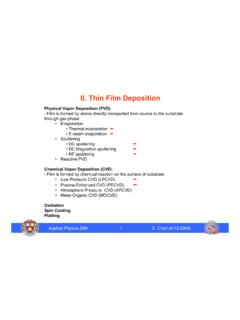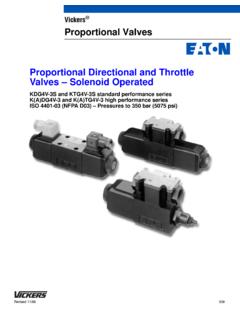Transcription of II. Thin Film Deposition - Harvard University
1 Applied Physics 298r1E. Chen (4-12-2004)II. Thin Film DepositionPhysical Vapor Deposition (PVD)-Film is formed by atoms directly transported from source to thesubstrate through gas phase Evaporation Thermal evaporation E-beam evaporation Sputtering DC sputtering DC Magnetron sputtering RF sputtering Reactive PVDC hemical Vapor Deposition (CVD)-Film is formed by chemical reaction on the surface of substrate Low-Pressure CVD (LPCVD) Plasma-Enhanced CVD (PECVD) Atmosphere-Pressure CVD (APCVD) Metal-Organic CVD (MOCVD)OxidationSpin CoatingPlattingApplied Physics 298r2E. Chen (4-12-2004)General Characteristics of Thin Film Deposition Deposition Rate Film Uniformity Across wafer uniformity Run-to-run uniformity Materials that can be deposited Metal Dielectric Polymer Quality of Film Physical and Chemical Properties Stress Adhesion Stoichiometry Film density, pinhole density Grain size, boundary property, and orientation Breakdown voltage Impurity level Deposition Directionality directional : good for lift-off, trench filling Non- directional : good for step coverage Cost of ownership and operationApplied Physics 298r3E.
2 Chen (4-12-2004)Evaporation Load the source material-to-be-deposited (evaporant) into the container (crucible) Heat the source to high temperature Source material evaporates Evaporantvapor transports to and Impinges on the surface of the substrate Evaporantcondenses on and is adsorbed by the surfaceCrucible (energy source)CurrentEvaporantVaporFilmSubstrat eApplied Physics 298r4E. Chen (4-12-2004)Langmuire-Knudsen RelationMass Deposition Rateper unit area of source surface:()PTPrTMCRemm =)(1coscos221 rePPSubstrateCm= : source-substrate distance (cm)T: source temperature (K)Pe:evaporantvapor pressure (torr), function of TP:chamber pressure (torr)M:evaporantgram-molecular mass (g)Source (K-Cell) Maximum Deposition rate reaches at high chamber vacuum (P ~ 0)Applied Physics 298r5E. Chen (4-12-2004)Uniform CoatingSpherical SurfaceSpherical surface with source on its edge: rePP0r02coscosrr== 20214rPTMCRemm = Angle Independent uniform coating!
3 Source (K-Cell) Used to coat instruments with spherical surfacesApplied Physics 298r6E. Chen (4-12-2004)Uniformity on a Flat SurfaceConsider the Deposition rate difference between wafer center and edge: ePPWafer1r2r2/W2111rR 42212222cos1rrrR= Define Uniformity:()()%%121 RRR = 2122212211rWrW + = 21=rWorSource (K-Cell)Applied Physics 298r7E. Chen (4-12-2004)Uniformity Requirement on a Flat Surface0204060801001201401600246810 Sample Size (W)Source-Sample Distance (r)1%2%5%10%Source-substrate distance requirement:In practice, it is typical to double this number to give some process margin: 2Wr> 2Wr>Larger r Means: bigger chamber higher capacity vacuum pump lower Deposition rate higher evaporantwasteAnother Common Solution:off-axis rotation of the sampleApplied Physics 298r8E. Chen (4-12-2004)Thickness Deposition Rate vs. Source Vapor PressureemARdtdh = rePPSource (K-Cell)SubstrateTdhFilmAeThickness Deposition rate()TPrTMCA dtdheme2211coscos =T: source temperature (K) Ae:source surface area (cm2) :evaporantdensity (g/cm3)Peis function of source Temperature!
4 Example: AlM ~ 27, ~ , Ae~ 10-2cm2, T ~ 900 KR ~ 50 cm (uniformity requirement)ePdtdh50=(A/s) The higher the vapor pressure, the higher the material s Deposition rateApplied Physics 298r9E. Chen (4-12-2004) Deposition Rate vs. Source TemperatureTypically for different material:)/()()100~10(sATPdtdhe= For Deposition rate > 1 A/s:Pe> ~ 100 mtorr Pedepends on: 1) materilaand 2) temperature Deposition rates are significantly different for different materials Hard to deposit multi-component (alloy) film without losing stoichiometryExample: for Pe> 100 mtoorT(Al) > 1400K, T(Ta) > 2500 KApplied Physics 298r10E. Chen (4-12-2004)Heating Method Thermal (Resist Heater)CrucibleResistive WireCurrentSourceMaterialFoil Dimple BoatAlumina CoatedFoil Dimple BoatContamination Problemwith Thermal EvaporationContainer material also evaporates, which contaminates the deposited filmCr Coated Tungsten RodApplied Physics 298r11E.
5 Chen (4-12-2004)CIMS Sharon Thermal EvaporatorApplied Physics 298r12E. Chen (4-12-2004)Heating Method e-Beam Heatere-Magnetic Field(beam focusing& positioning)EvaporantEvaporantCrucibleCa thode FilamentFocusingApertureElectron BeamWater Cooled Rotary Copper Hearth(Sequential Deposition )Advantage of E-Beam Evaporation:Very low container contaminationApplied Physics 298r13E. Chen (4-12-2004)CIMS Sharon E-Beam EvaporatorApplied Physics 298r14E. Chen (4-12-2004)ComparisonHigh~ 3000 C10 ~ 100 A/sLowEverything above, plus:Ni, Pt, Ir, Rh, Ti, V, Zr, W, Ta, MoAl2O3, SiO, SiO2, SnO2, TiO2, ZrO2 Both metal and dielectricsE-BeamLow~ 1800 C1 ~ 20 A/sHighAu, Ag, Al, Cr, Sn, Sb, Ge, In, Mg, GaCdS, PbS, CdSe, NaCl, KCl, AgCl, MgF2, CaF2, PbCl2 Metal or low melt-point materialsThermalCostTemperature RangeDeposition RateImpurityTypical EvaporantMaterialDepositionStoichiometri calProblem of Evaporation Compound material breaks down at high temperature Each component has different vapor pressure, therefore differentdeposition rate, resulting in a film with different stoichiometrycompared to the sourceApplied Physics 298r15E.
6 Chen (4-12-2004)Typical Boat/Crucible Material16002500 Boron Nitride (BN)19002030 Alumina (Al2O3)26003799 Graphitic Carbon (C)Refractory Ceramics25302620 Molybdenum (Mo)30603000 Tantalum (Ta)32303380 Tungsten (W)Temperature for 10-mtorr Vapor Pressure (Pe)( C)Melting Point( C)MaterialRefractory MetalsApplied Physics 298r16E. Chen (4-12-2004)DC Diode Sputtering DepositionSubstrate (Anode)2 5kVe-Target (Cathode)e-e- ArArAr+ Target (source) and substrate are placed on two parallel electrodes (diode) They are placed inside a chamber filled with inert gas (Ar) DC voltage (~ kV) is applied to the diode Free electron in the chamber are accelerated by the e-field These energetic free electrons inelasticallycollide with Aratoms excitation of Ar gasglows ionization of Ar Ar+ + 2ndelectron 2ndelectrons repeat above process gas breakdown discharge glow (plasma)Applied Physics 298r17E.
7 Chen (4-12-2004)Self-Sustained Discharge Near the cathode, electrons move much faster than ions because of smaller mass positive charge build up near the cathode, raising the potential of plasma less electrons collide with Ar few collision with these high energetic electrons results in mostly ionization, rather than excitation dark zone (CrookesDark Space) Discharge causes voltage between the electrodes reduced from ~103 V to ~102V, mainly across the dark space Electrical field in other area is significantly reduced by screening effect of the position charge in front of cathode Positive ions entering the dark space are accelerated toward the cathode (target), bombarding (sputtering) the target atoms locked out from the target transport to the substrate (momentum transfer, not evaporation!) generate 2ndelectrons that sustains the discharge (plasma)Substrate (Anode)Target (Cathode)CrookesDark Space+++++Ar+Ar+tt2 5kVApplied Physics 298r18E.
8 Chen (4-12-2004)Requirement for Self-Sustained Discharge If the cathode-anode space (L) is less than the dark space length ionization, few excitation cannot sustain discharge On the other hand, if the Arpressure in the chamber is too low Large electron mean-free path 2ndelectrons reach anode before colliding with Aratoms cannot sustain discharge either )( > Condition for Sustain Plasma:L: electrode spacing, P: chamber pressureFor example:Typical target-substrate spacing: L ~ 10cm P > 50 mtorrApplied Physics 298r19E. Chen (4-12-2004) Deposition Rate vs. Chamber PressureHigh chamber pressure results in low Deposition rateMean-free path of an atom in a gas ambient:In fact, sputtering Deposition rate R: )()(105~3cmtorrP PLR 1 Use previous example:L = 10 cm, P = 50 mtorr ~ cm sputtered atoms have to go through hundreds of collisions before reaching the substrate significantly reduces Deposition rate also causes source to deposit on chamber wall and redeposit back to the target Large LP to sustain plasma small LP to maintain good Deposition rate and reduce random scattering?
9 Applied Physics 298r20E. Chen (4-12-2004)DC Magnetron Sputtering Using low chamber pressure to maintain high Deposition rate Using magnetic field to confine electrons near the target to sustain plasmaTargetSSSSNNC athode (Target)e-+B+EApply magnetic field parallel to the cathode surface electrons will hope (cycloid) near the surface (trapped)Applied Physics 298r21E. Chen (4-12-2004)Impact of Magnetic Field on IonsHoping radius r:dVemBr21~Ar+Cathode (Target)e-+BErVd voltage drop across dark space(~ 100 V)B Magnetic field (~ 100 G)For electron r ~ cmFor Ar+ ion:r ~ 81 cmApplied Physics 298r22E. Chen (4-12-2004)As A Result .. current density ( proportional to ionization rate) increases by 100 times required discharge pressure drops 100 times Deposition rate increases 100 times~ 1mT~ 100mTChamber Pressure (P) Deposition Rate (R)MagnetronNon-MagnetronApplied Physics 298r23E.
10 Chen (4-12-2004)RF (Radio Frequency) SputteringDC sputtering cannot be used for depositing dielectrics because insulating cathode will cause charge build up during Ar+bombarding reduce the voltage between electrodes discharge MHze-Are-Ar+tTargetTarget SheathSubstrate Sheath~Solution: use AC power at low frequency (< 100 KHz), both electrons and ions can follow the switching of the voltage DC sputtering at high frequency (> 1 MHz), heave ions cannot no long follow the switching ions are accelerated by dark-space (sheath) voltage electron neutralizes the positive charge buildup on both electrodes However, there are two dark spaces sputter both target and substrate at different cycleApplied Physics 298r24E. Chen (4-12-2004)RF (Radio Frequency) MHzTarget~VTVSATAS()2~nAAVVnTSST VT voltage across target sheathVs voltage across substrate sheathAT area of target electrodeAs area of substrate electrodeLarger dark-space voltage develops at the electrode with smaller area make target electrode smallApplied Physics 298r25E.







